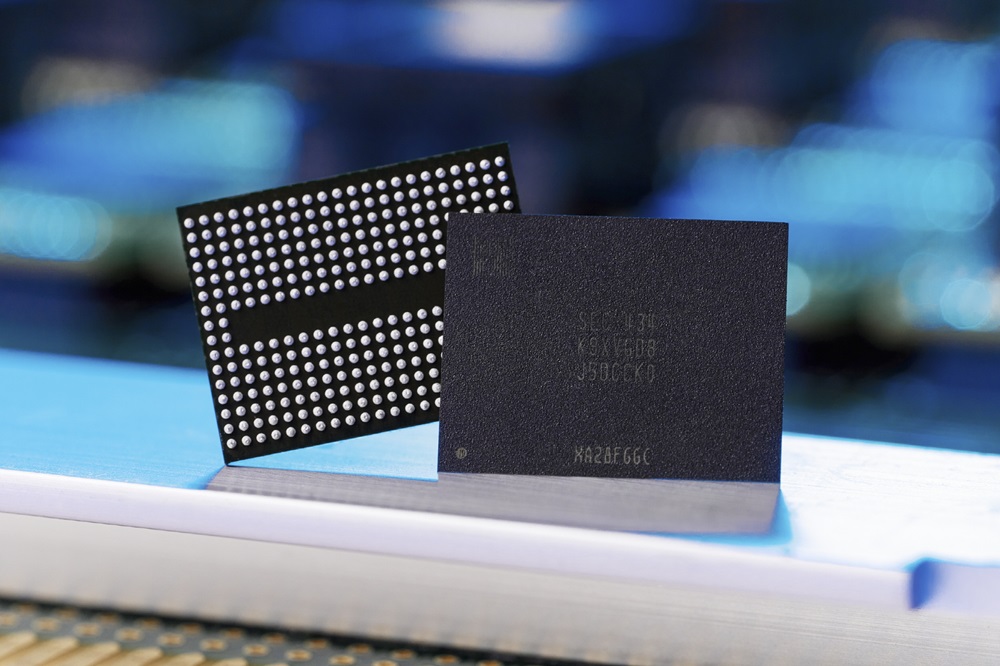Samsung prepares to unveil 10th generation V-NAND with 400+ layers — ready to power future PCIe 5.0 and 6.0 SSDs
With 1Tb 5.6 GT/s 3D TLC NAND, it can target pretty much everything.

Samsung has yet to introduce full-fat PCIe 5.0 solid-state drives at retail — we don't really count the PCIe 5.0 x2 / PCIe 4.0 x4 990 Evo and 990 Evo Plus — but it's preparing flash memory that will be able to power not only the fastest PCIe 5.0 SSDs, but could also support next-generation PCIe 6.0 drives. The new 4xx-layer 3D NAND devices will have an interface speed of 5.6 GT/s and will be presented at the upcoming International Solid-State Circuits Conference (ISSCC).
Samsung's ultra-fast 10th Generation V-NAND memory maintains the TLC (Tri-Level Cell, or three bits per cell) architecture and has a capacity of 1Tb (128 GB) per die. Samsung claims that its new 4xx-layer 3D TLC NAND has a storage density of 28 Gb/mm². That's just slightly lower than Samsung's 1Tb 3D QLC V-NAND, which has a storage density of 28.5 Gb/mm², currently the world's densest non-volatile memory.
Current NAND chips typically have either eight or 16 NAND dies per package. That means 16-die packages would offer up 2TB of storage, and four such packages on a single-sided SSD would enable 8TB of storage — or up to 16TB on a dual-sided M.2 2280 drive. (Note that Samsung hasn't created a new dual-sided SSD in quite some time, opting to stick with single-sided designs.)
Arguably, the most important feature of Samsung's 10th Generation V-NAND is its interface speed: 5.6 GT/s, which is significantly faster than the 3.6 GT/s featured by YMTC's memory with Xtacking architecture. At 5.6 GT/s, this equates to around 700 MB/s, which means that 10 of these devices could saturate a PCIe 4.0 x4 interface, and 20 will be enough to saturate an ultra-fast PCIe 5.0 x4 interface. That's what powers the fastest options among the world's best SSDs. With the potential for up to 32 dies in two NAND packages, that's already half way to reaching maximum throughput on a PCIe 6.0 x4 interface.
Samsung plans to unveil its 10th Generation V-NAND memory at ISSCC 2025, and it's reasonable to expect the company will start volume production of this non-volatile memory next year as well. Unfortunately, it's not clear when the new memory will find their way into Samsung's own SSDs. Typically, new NAND solutions can be used in a variety of retail products, including USB drives, memory cards, SSDs, smartphones, and more. Even if production on the 10th Generation V-NAND begins in 2025, it's unclear whether we'll see that memory implemented in Samsung SSDs next year.
Get Tom's Hardware's best news and in-depth reviews, straight to your inbox.

Anton Shilov is a contributing writer at Tom’s Hardware. Over the past couple of decades, he has covered everything from CPUs and GPUs to supercomputers and from modern process technologies and latest fab tools to high-tech industry trends.
-
2Be_or_Not2Be I'm waiting for Samsung to release a true PCIe 5.0 product. They've been sitting on their laurels a bit, and Phison is feasting while they're out. Competition in storage is always good for the consumer!Reply -
pixelpusher220 Reply
I'm probably moving solidly into 'the olds' category but it boggles my mind the speeds being offered here. And the cooling that's going to be required for anything even starting to tax the read/write rates2Be_or_Not2Be said:I'm waiting for Samsung to release a true PCIe 5.0 product. They've been sitting on their laurels a bit, and Phison is feasting while they're out. Competition in storage is always good for the consumer! -
jp7189 Reply
..and why, if they are touting the highest density, have they been stuck at 4TB for so long?2Be_or_Not2Be said:I'm waiting for Samsung to release a true PCIe 5.0 product. They've been sitting on their laurels a bit, and Phison is feasting while they're out. Competition in storage is always good for the consumer! -
Tanquen 400 plus layers for density sounds cool and all but until they come up with a controller or file system, that can do better than a few hundred MB per second with smaller files, who cares? Sure, it's fun to copy large VMs or 80 GB 4K Blu-ray ISOs and the like but there's not a lot of extra performance when dealing with lots of smaller files in programs that are installed and running.Reply -
Tanquen Reply
I would love some inexpensive 2.5", 8 TB or 16 TB serial ATA drives for my NAS. It's just not going to happen as long as they can sell 4 TB M.2 drives for $300 or $400 or more.jp7189 said:..and why, if they are touting the highest density, have they been stuck at 4TB for so long?